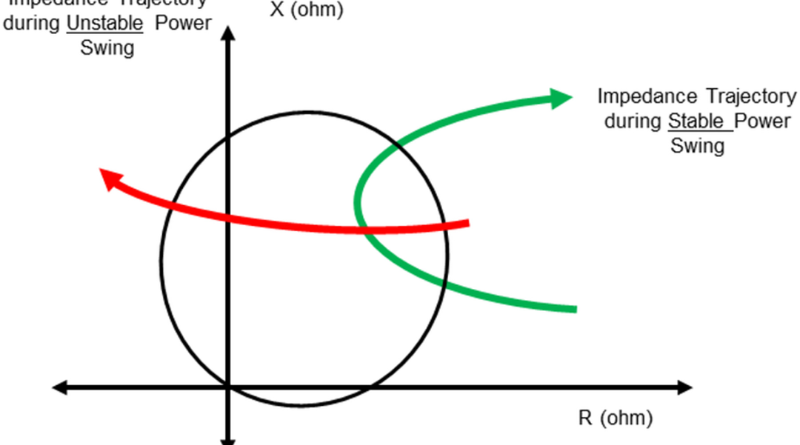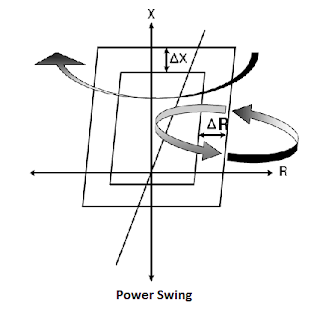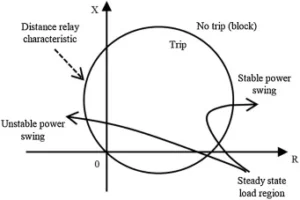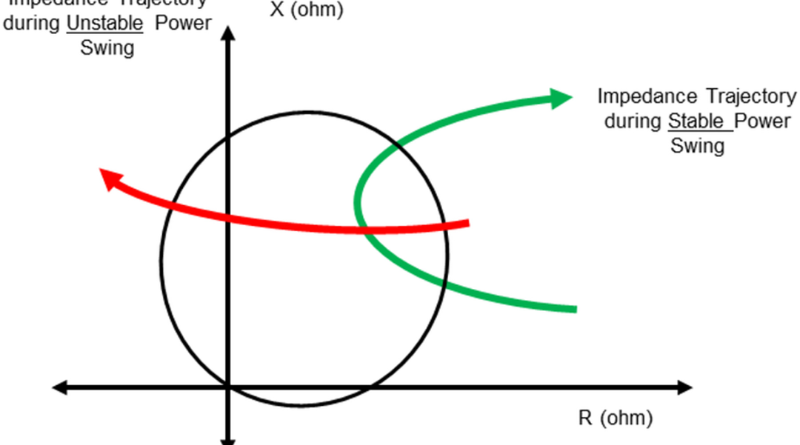
Some faults are temporary and distance relays or trip switches do not perform an essential function. These temporary disturbances are categorized as power fluctuations, as shown in the figure.

To detect fluctuations in performance, certain conditions must be checked. They are listed below:
- No earth fault detection (no zero current)
- No phase-to-phase error (no negative sequence current)
- The change in ohmic resistance (impedance) over time occurs in three phases and is less than some set values (ΔR and ΔX).
Power Balance Overview
The power pendulum, a fascinating phenomenon in electrical systems, involves the dynamic oscillation of power flows and voltages in interconnected networks. Understanding and deciphering the secrets of power fluctuations is crucial to ensuring grid stability and preventing potential disruptions.
When you delve deeper into the basics, it becomes clear that grid fluctuations are often triggered by system disturbances or sudden changes in load conditions. Detecting and monitoring grid fluctuations requires sophisticated technologies such as protective relays and synchrophasors, which provide real-time data and measurement accuracy. When analyzing network fluctuations, mathematical models and dynamic simulations are used to assess system stability. Effective mitigation and control strategies, such as reactive power compensation and emergency control systems, are crucial to minimizing the risks associated with grid fluctuations.
Studying case studies and real-world examples and identifying successful strategies for mitigating variability issues can provide us with valuable insights. Looking to the future, new technologies, such as artificial intelligence and machine learning, promise to improve fluctuation detection and control algorithms. With a comprehensive understanding of the risk of fluctuations and continuous advances in analysis techniques, we can unlock its secrets and ensure the reliability and stability of electrical systems.

Importance of Power Swing dynamics
The dynamics of power fluctuations are critical in electrical systems, as they can cause voltage instability and potential damage to equipment, requiring effective protective measures. Understanding and analyzing the dynamics of power fluctuations allows the development of reliable strategies to maintain grid stability and avoid disruptions.
Network stability
The dynamics of power fluctuations have a direct impact on the stability of the electrical grid. Power fluctuations can cause temporary outages that affect the balance between production and demand, which can lead to voltage and frequency fluctuations. By understanding the dynamics of power fluctuations, system operators and engineers can take appropriate measures to maintain grid stability and avoid cascading failures that could lead to widespread blackouts or outages.
Protection relay operation
Protection relays are essential for detecting and responding to abnormal conditions in the electrical network. Understanding power swing dynamics is essential for designing and configuring protective relays to accurately distinguish between true faults and transient power swing events. Proper coordination and adjustment of settings ensures selective and reliable operation of protective relays, minimizing unnecessary trips and ensuring optimal system performance.
Network planning and expansion
The dynamics of power fluctuations must be taken into account in network planning and expansion. By analyzing historical data on power fluctuations and studying existing grid behavior, engineers can identify potential challenges and design robust transmission systems that can accommodate power fluctuations without compromising stability. A thorough understanding of power fluctuations helps you select the appropriate equipment and implement the control measures necessary to handle future load fluctuations and system outages.
System protection and resilience
The dynamics of network fluctuations can significantly influence the protection systems used in the electrical network. Understanding the behavior and characteristics of power system fluctuations is critical to ensuring reliable operation of protective equipment. Failure to consider the dynamics of network fluctuations can lead to inadequate protection coordination, false relay trips and compromised system stability. By understanding the dynamics of network fluctuations, engineers can develop protection strategies that effectively respond to network fluctuations, protect the system against failures, and ensure efficient troubleshooting.
System optimization and efficiency
The dynamics of power fluctuations can affect the overall efficiency of the power system. By understanding the causes and behavior of performance fluctuations, engineers can identify areas for improvement and implement optimization measures. This may include implementing advanced control algorithms, leveraging reactive power compensation techniques, or upgrading system components to minimize the impact of power fluctuations and improve system efficiency.
Understanding oscillation dynamics is critical to network stability, protective relay operation, network planning, system protection, and overall system optimization. By understanding the complexities of pendulum dynamics, systems engineers and operators can make informed decisions, take appropriate actions, and ensure the reliable and efficient operation of electrical systems.
Causes and triggers of performance fluctuations
Research into the causes and triggers of power fluctuations is crucial to understanding the dynamics and behavior of this phenomenon in electrical systems. Performance fluctuations can be triggered by a variety of factors, and understanding their causes is essential for effective analysis and mitigation strategies. Here are some common causes and triggers of performance fluctuations:
System imbalance
Power fluctuations can occur when there is an imbalance between generation and load on the electrical grid. This imbalance can arise from sudden changes in load demand, failures in generators or transmission lines, or inadequate reactive power support. As a result, the electrical grid experiences fluctuations as it tries to restore balance between generation and load.
Faults and resolution mechanisms
Defects in the electrical network can also cause performance fluctuations. For example, when a fault occurs in a transmission line or generator, protective devices such as circuit breakers are activated to clear the fault. The sudden change in system configuration and subsequent recovery of the failed element can trigger performance fluctuations as the system adapts to new operating conditions.
Network configuration changes
Performance fluctuations can be triggered by changes in network configuration, such as: B. switching operations or adding/removing significant load or generation. These changes alter the system's energy flow and cause temporary imbalances and fluctuations in performance.
Network errors or instabilities
Certain network errors or instabilities, such as voltage drops or system resonances, can lead to performance fluctuations. These conditions can result in rapid changes in voltage and current, causing fluctuations in the electrical network.
Loss of sync
Power fluctuations can occur when synchronization between system generators is lost. This can happen if a generator loses connection to the grid or if synchronization signals are interrupted. The resulting imbalance between generator output and system demand can trigger power fluctuations.
Understanding the causes and triggers of network fluctuations is fundamental to developing effective protection and control systems. This allows engineers to develop strategies to detect and mitigate grid fluctuations, optimize system stability, and ensure reliable operation of electrical systems. By analyzing these causes, engineers can identify vulnerabilities, implement appropriate control measures, and improve the resilience of the power grid to grid fluctuations.
Properties and behavior of pendular processes
Understanding the characteristics and behavior of power fluctuations is essential for the effective analysis and management of this dynamic phenomenon in electrical systems. Engineers can develop strategies to ensure system stability and reliability by studying the system's unique characteristics and behavior. Here are the main aspects to consider:
Oscillating nature
The oscillating behavior of power flows, voltages and currents within the electrical network characterizes power oscillation. During a power surge, these values fluctuate as the system tries to restore balance. The frequency, strength and duration of the oscillations can vary depending on the specific conditions that trigger the power oscillation.
Swing angle and swing curve
The oscillation angle represents the phase difference between the generator rotor angles during a power oscillation. It is a crucial parameter for understanding the behavior of power oscillation. The swing curve is a graphical representation of the relationship between swing angle and time. Swing curve analysis helps assess the severity and duration of power swings, allowing operators to make informed decisions and take appropriate actions.
Frequency and attenuation
Energy fluctuations can have different frequencies depending on the dynamics of the system. The fluctuation frequency refers to the speed at which the electrical grid oscillates. Damping refers to the gradual reduction in the amplitude of power fluctuations over time. Understanding frequency and damping characteristics helps engineers develop control strategies to mitigate the effects of power fluctuations and prevent system instability.
Critical release time
Critical recovery time (CCT) is a crucial parameter in network fluctuation analysis. Indicates the time required to resolve an error and restore system stability before network fluctuation becomes unstable. By accurately determining the CCT, engineers can design protective relays and control systems that enable timely troubleshooting and prevent instabilities during grid fluctuations.
Interaction with protection systems
Power fluctuations can affect the performance of protective relays and related systems. Understanding the interaction between power fluctuations and protection systems is critical to avoiding unnecessary tripping or delays in protection devices. This includes coordinating relay configurations, implementing adaptive protection schemes, and using large-scale monitoring and control systems.
By understanding the characteristics and behavior of grid fluctuations, engineers can develop effective strategies to detect, analyze and mitigate their impact on the power grid. This understanding helps in the development of protective relays, control algorithms and stability improvement measures to ensure reliable and stable operation of electrical systems during grid fluctuations.
Technologies and advances in power pendulum analysis
New technologies and advances in grid fluctuation analysis are revolutionizing the monitoring, analysis and protection of power grids. These innovative approaches provide better opportunities to detect, analyze and mitigate grid fluctuations, ensuring the stability and reliability of electrical networks. Here are some notable advances in network fluctuation analysis:
Synchrophasor technology
Synchrophasor technology has proven to be a revolutionary innovation in network pendulum analysis. These are high-precision, time-synchronized measurements from Phasor Measurement Units (PMUs) strategically distributed across the network. These measurements provide real-time data on voltage, current and frequency with high accuracy and temporal resolution, enabling accurate analysis of network oscillation dynamics. Synchrophasors enable large-scale monitoring and control systems, allowing operators to quickly detect and respond to grid surge events.
Large-scale surveillance systems
Large-scale monitoring systems use synchronous phase data and advanced analytics to comprehensively visualize the dynamic behavior of the power grid. These systems analyze data from multiple locations to detect performance fluctuations, evaluate their characteristics, and evaluate the impact on system stability. By leveraging large-scale monitoring, operators gain valuable insights into power fluctuation patterns, enabling them to make informed decisions and take appropriate control measures to maintain grid stability.
Machine learning and artificial intelligence
Two commonly used terms in technology are machine learning and artificial intelligence (AI). The techniques are increasingly being used in network oscillation analysis. These technologies enable the development of advanced algorithms that automatically detect, classify and predict grid oscillation events based on historical data and real-time measurements. Machine learning algorithms can learn patterns and anomalies associated with network oscillation, improving the accuracy and speed of network oscillation detection and analysis.
Advanced protection and control systems
With advances in grid fluctuation analysis, protection and control systems have become increasingly sophisticated. New relays and protection algorithms feature improved logic and adaptive settings that accurately distinguish between line fluctuations and true faults. These advancements minimize unnecessary relay operations, shorten trip times, and improve the overall reliability of protection systems.
Network Digitization and IoT Integration
The digitalization of the electrical grid and the integration of the Internet of Things (IoT) allow for better monitoring and analysis of grid fluctuations. Smart grid technologies, as well as modern sensors and communication systems, provide real-time data on the state of the electrical grid. This wealth of information improves analysis of network fluctuations and enables timely detection, accurate characterization, and effective control of network fluctuations.
These new technologies and advancements are transforming the way network fluctuations are analyzed, providing operators and engineers with comprehensive insight and enabling faster, more accurate decisions. By leveraging these advances, power systems can proactively manage grid fluctuations, ensure grid stability, and optimize the reliable operation of power grids.
Conclusion
In summary, new technologies and advances in grid fluctuation analysis, such as phase synchronous technology, large-scale monitoring systems and machine learning, are fundamentally changing the way electrical systems are monitored and protected. These innovations provide real-time data, advanced analytics and accurate information to detect and mitigate network fluctuations, ensuring network stability and improved system performance. Continued research and development of these technologies will improve our ability to manage and mitigate the impact of grid fluctuations, ensuring resilient and reliable energy systems.

